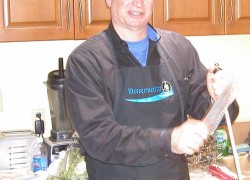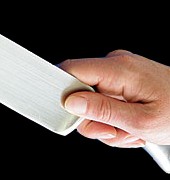HOW TO SLICE, DICE, JULLIENE, BATONNET, ALLUMETTE, CHIFFONADE, CHOP, MINCE AND MORE!
Not many of us realize that handling a knife is a work of art. I knew nothing about the anatomy of a knife or the classic pinch grip or the various techniques of using a knife till I took a knife skills class today taught by Ethan Hamme of Messermeister at theFaradays Kitchen Store.
Even though I proudly own an 8 inch Wusthof Chef’s Knife gifted by my dearest friends who know my passion for cooking; My understanding of handling, using and caring for a chef’s knife increased in an hour’s session at the knife skills class with Mr. Hamme. He is the national sales manager of Messermeister. Messermeister is a premier brand with a wide collection of cutlery and culinary tools to food-service professionals and home cooks.
The knife skills workshop was hosted at Faradays Kitchen Store, an exclusive kitchen store of Cookware, Bakeware, Cutlery, and Kitchen Gadgets in Lakeway, Austin. With a motto of “feeding your passion for cooking”, the owners Tony & Melissa Curtis-Wellings host many such culinary workshops.
This hands-on class started with each of us holding a chef’s knife, to understand its anatomy and terminology. Chef’s knives are measured in inches, and lengths of 8″ to 12″ are common, though some range from 4″ to 14″. The broad bladed knife has a spine which tapers to the cambered or arched cutting edge and creates a pointed tip. The knife also has a bolster, which is the thick shoulder of heavy steel at the front of the handle. In addition to balancing the knife, the bolster also helps keep fingers from slipping thus preventing hand fatigue and blisters. Because of this geometry, the knife is well balanced with weight distributed equally between the hand and the blade.
The blade is shaped so that it can peel, trim, slice, chop and mince vegetables; fillet fish and cut meat! Each part of the knife performs different tasks. The tip works in paring, coring, trimming and peeling. The middle edge is best in slicing, dicing, chopping, and precision cuts. Whereas the heel, the widest part of the knife, located at the rear of the blade is used for chopping hard items like carrots, nuts or even chicken bones. The spine can be used to crack shells and the flat side of the blade can crush garlic.
While gripping the chef’s knife, many of us at the workshop realized how differently each of us was holding our knives all these years. The classic knife grip is to pinch your thumb and forefinger on either side of the heel, just above the bolster. The spine of the knife should be resting just above the second joint of your index finger, while you lightly grip the handle and place your middle finger against the back of the bolster. This grip allows you to be over the top of the knife and gain maximum control.
To master our newly acquired skills of holding the chef knife we worked on slicing and dicing different vegetables. To slice celery we glided the knife forward and down with the heel of the knife lifted and tip remaining on the board. While for carrots we used a raised knife technique. We also learn to slice it in rondelles, diagnol cuts, oblique cuts,julliene, and batonett.
To slice and chop an onion is not an easy task, apart from the tears. Ethan showed us the pull and parallel technique to finely dice and chop onions, while sharing with us the trick of not cutting the root of the onion to keep the onion from spreading apart while dicing. We were also shown how to cut bell peppers, julienne and brunoisethem; and how to julienne potatoes to make fries besides dice and cube them. Finally we also learnt the art of finely mincing herbs like parsley or cilantro by placing the palm of the other hand on the spine of the knife few inches from the tip and rocking the knife to get a fine mince of herbs.
Lastly we were told how to care for our knives and how to keep the blade sharp and aligned. After using the knife, it’s good to wash and clean the knife and align it on the steel before storing it back. We were also reminded not to put the knife in a dishwasher as constant action, detergent and excessive heat dulls the edge.
This one hour hands-on knife skills workshop was very instructive and helpful. After acquiring these skills, cutting feels very therapeutic and prep work becomes part of the pleasure of cooking. Besides, cutting the vegetables right also enhances the textures and flavors of the food you cook. I highly recommend this class to all who enjoy cooking!





